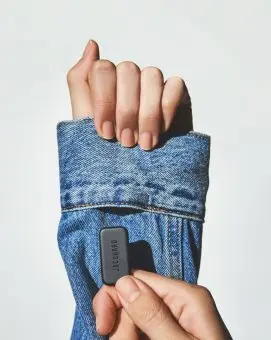
Google’s Advanced Technology and Project (ATAP) division has created Jacquard, a wearable platform that brings the digital world into everyday experiences. The Jacquard team used Stratasys‘ PolyJet technology to create a product that fits seamlessly into its user’s lifestyle.
ATAP focuses on creating novel products that enhance humans’ tech experiences. The team aims to develop products that can be integrated into multiple areas of human experience, with the versatility to help users in a range of different environments and experiences.
The platform includes an app and a physical tag that can be incorporated into many soft goods, allowing for interactive digital experiences without needing to physically hold a device. The Jacquard Tag itself is a small, sleek tag that can be modified to fit into almost any product, and that’s entirely the point: “Our designs are meant to disappear. They’re meant to fit seamlessly into our aesthetic surroundings,” said Bryan Allen, technical program manager and ATAP Lab lead.

The tag senses a motion, like swiping or tapping, which allows the user to perform actions such as pausing music, taking a photo or answering a phone call.
Manufacturing on Demand
The team’s complex task, gracefully merging a hard goods and soft goods product pipeline, was overcome with the help of Stratasys’ PolyJet technology. PolyJet printers, like the J8 Series, combine excellent resolution with a wide range of material offerings and workflow capabilities. These printers are also Pantone-validated, thus offering thousands of unique shades and the ability to simulate surface textures from wood grain to leather.
PolyJet’s versatility allowed designers to jump in at any stage of the design process to create prototypes from single-color concept models to functional multi-material prototypes. Parts printed with flexible materials allowed for further part realism.
Stratasys has made that process easier with support for KeyShot 10 rendering software and the 3MF file format. By saving designs to 3MF, KeyShot produces files ready for printing, with accurate colors and displacement maps to three-dimensional simulate textures. The Google ATAP team was a key beta customer.
The ATAP team has so far used the Jacquard platform to incorporate the tag into the sleeve of a denim jacket, introduce a wearable gaming athletic shoe and create a smart backpack. More applications are to come.
Meanwhile, the team continues to use 3D printing in new ways. ATAP is even beginning to use Stratasys’ Digital Anatomy technology to improve functional material performance. The PolyJet-based Digital Anatomy 3D printer replicates the appearance, texture, and responsiveness of human anatomy, including tissue, bone, and muscle. The printer was designed to improve surgical preparedness and training and help test new medical devices; it has found a home with the Google ATAP Lab team.
* This article is reprinted from 3D Printing Media Network. If you are involved in infringement, please contact us to delete it.
Author: Adam Strömbergsson

Leave A Comment